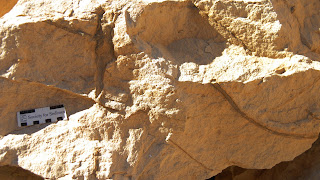Sedimentary Structures and Bedforms
Wave Ripples
Wave ripples are characterized by symetrical profile to the wave crest.This is taken in July 13th 2011 in Eric's study area where Pa.6 is interpreted as wave influenced, fluival-dominated delta front deposits.
2-D Current Ripple
Picture was taken in Summiyah's area. Relative straight crests make them 2-D ripples. The asymetrical profile is diagnostic of current ripples.
3-D Current Ripples
Picture was taken in Dan Fix's study area in Henry Wash. The sinous crests make them 3-D ripples. Fluival channel and floodplain deposits are interpreted in the upper Ferron Sandstone.
Current Ripple Cross Lamination
Current ripple cross lamination shows a unidirectional dipping pattern, which indicates the paleoflow direction (generally to the right). The thicknesses of current ripple cross lamination are commonly less than 7cm and are mostly 2-3 cm.
Normal Grading
Picture shows a milimeter scale normal grading in a prodelta depositional environment. The base of normal grading is commonly associated with a scour surface, indicating erosional process of a turbidite. It is taken at the highway 24 road cut of pa.6. Ferron Sandstone.
Starved Ripples
Picture shows starved ripples which are formed under a condition of low sediment supply rate.
Bouma Sequence AB
Picture from the Panther Togue Sandstone Star Point Formation shows a series of massive to planar laminated sandstone, representing Bouma sequence AB.
Hummocky Cross Stratification
Both lee and stoss sides of the ripples are preserved, the climbing angle is less than 60 degree. They will be classified as type B according to Allen J.R. 1973.
Wave ripples are characterized by symetrical profile to the wave crest.This is taken in July 13th 2011 in Eric's study area where Pa.6 is interpreted as wave influenced, fluival-dominated delta front deposits.
2-D Current Ripple
Picture was taken in Summiyah's area. Relative straight crests make them 2-D ripples. The asymetrical profile is diagnostic of current ripples.
3-D Current Ripples
Picture was taken in Dan Fix's study area in Henry Wash. The sinous crests make them 3-D ripples. Fluival channel and floodplain deposits are interpreted in the upper Ferron Sandstone.
Current Ripple Cross Lamination
Current ripple cross lamination shows a unidirectional dipping pattern, which indicates the paleoflow direction (generally to the right). The thicknesses of current ripple cross lamination are commonly less than 7cm and are mostly 2-3 cm.
Normal Grading
Picture shows a milimeter scale normal grading in a prodelta depositional environment. The base of normal grading is commonly associated with a scour surface, indicating erosional process of a turbidite. It is taken at the highway 24 road cut of pa.6. Ferron Sandstone.
Starved Ripples
Picture shows starved ripples which are formed under a condition of low sediment supply rate.
Bouma Sequence AB
Picture from the Panther Togue Sandstone Star Point Formation shows a series of massive to planar laminated sandstone, representing Bouma sequence AB.
Hummocky Cross Stratification
 | ||
| Climbing Ripples (Type B, acoording to Allen J.R.) |











Comments
Post a Comment